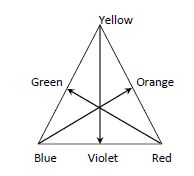Young-Helmholtz-Maxwell Theory Of Colour Vision:
Thomas Young (1801) proposed the eye perceived colour in terms of three principal or primary colour stimuli. He suggested Red, Yellow and Blue. Later he amended it to Red, Green and Violet.
W.H. Wollaston (1802) suggested colours in sunlight are neither 7 nor 3 , but 4 namley Red, Yellowish green, Blue & Violet.
Dr. Brewster (1831) said that Red-Yellow-Blue was correct after an intensive work with light in the dark room.
Helmholtz (1852) said “Colour mixture of light and pigment obey different law and cannot predict one another”. That is he recognised the difference between the additive and subtractive colour mixing.
Trichromatic Theory of color:
- Additive color is color created by mixing light of two or more different colors. Red, green, and blue are the additive primary colors normally used in additive color system.
- Additive color is in contrast to subtractive color, in which colors are created by subtracting (absorbing) parts of the spectrum of light present in ordinary white light, by means of colored pigments or dyes, such as those in paints, inks, and the three dye layers in typical color photographs on film.
- Computer monitors and televisions are the most common examples of additive color. Another example of additive color can be found in the overlapping projected colored lights often used in theatrical lighting for plays, concerts, circus shows and night clubs.
Fig. Additive color mixing: adding red to green yields yellow; adding all three primary colors together yields white.
The addition of these three primaries gives the following colors-
Red + Green=Yellow
Green+ Blue =Cyan
Blue+ Red=Magenta
The mixing of these three colors in equal quantity produces white light.
2.Subtractive or Pigment theory:
- In pigment/subtractive theory, the primary colors are red, yellow and blue. The mixing of these three colors in equal quantity produces black shade.
- The addition of these three primaries gives the following colors-
Yellow + Blue=Green
- A subtractive color model explains the mixing of a limited set of dyes, inks, paint pigments or natural colorants to create a wider range of colors, each the result of partially or completely subtracting (that is, absorbing) some wavelengths of light and not others. The color that a surface displays depends on which parts of the visible spectrum are not absorbed and therefore remain visible.












0 Comments